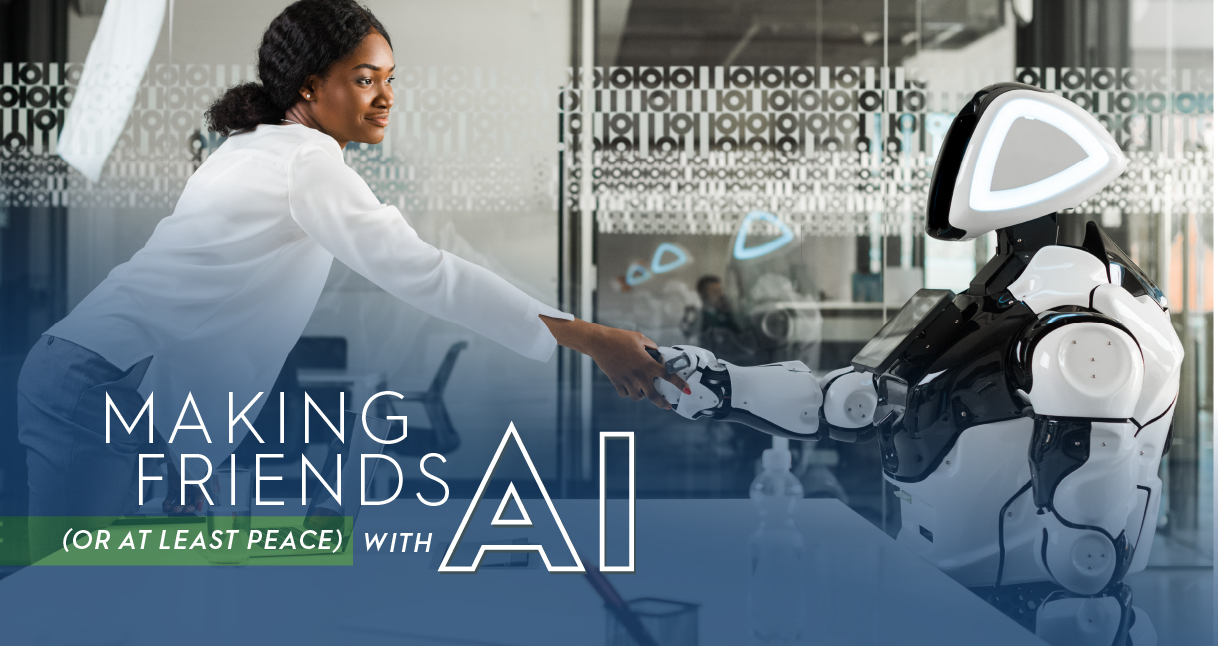Walmart is Dominating Amazon in Grocery Sales and is Poised for Continued Growth
Walmart is making significant strides in online sales and has…
We are based in historic Annapolis, Maryland, but our team is nationwide. Contact us today to learn how we can help amplify your brand.
Walmart is making significant strides in online sales and has…
Compass team leaders weigh in on what it means to…
More and more Americans are using generative AI tools in…

In late 2022 and early 2023, artificial intelligence was among the most unavoidable topics on the internet. If the chatter has since died down somewhat, it is not due to lack of advancement. To the contrary, AI is moving faster than ever, integrating itself into the working lives of Americans at a rate that seemed unthinkable when the decade began.
Perhaps the best example comes in the form of this striking statistic from September: 25.6% of U.S. internet users will utilize generative AI at least monthly this year.1 Of these, more than half are using it in the workplace.2 And to be even more specific, a significant number of these workers—projected to be 26.6% in 2025—are entering prompts into generative tools like ChatGPT.3
ChatGPT itself seems to have become smarter and more effective—especially in its more sophisticated GPT-4 form—as compared to the early part of 2023. In theory, this is unsurprising: gradual learning and refinement are famously built into the model. But in practice, the dexterity with which AI tools can generate serviceable (and even genuinely good) content remains daunting to those whose roles were once defined by purely human effort.
But perhaps there is still a balance to be struck.
Take the example of a modern marketing mainstay: social media campaigns. (Though social media ad spend is shrinking, brands still need a presence on social platforms.) An Insider Intelligence article suggests a few ways in which ChatGPT can help.4
A prompt that includes a brand or product, the target market, and the desired social platform can generate unique ideas for posts. The results can get surprisingly specific, and they can always be adjusted to apply the same concepts to different platforms. At the same time, human professionals remain vital to the process, in part because there’s still an element to the social media experience—for example, understanding the subtleties of trends and memes—that AI cannot quite replicate.
Keep in mind that alt text is subject to character limits. To use the example of the world’s leading eCommerce platform, Amazon imposes a maximum of 100 characters of alt text for A+ images. Taking full advantage of this limited unseen real estate is one of the bedrock principles of a winning alt text strategy.
Other things to keep in mind: There is no need for punctuation or correct grammar, repetition of words should be avoided, and some words may be restricted by the platform. The best alt text strikes a balance between the descriptive and SEO functions—that is, making the contents of an image truly clear while also making sure to include some words or terms for which people are actually searching. (The latter can be revealed through a tool like Jungle Scout.)
Can you see why alt text is the perfect venue for a bilingual approach? Imagine a visually impaired Amazon shopper of Mexican origin who is more comfortable speaking Spanish, but whose English is solid and steadily improving. The screen reader presents her with a description of the A+ images succinctly but accurately describing what she would be seeing under perfect conditions. The words might break down to 75% English, 25% Spanish.
Even with the most solid ideas in place, a campaign can still fail for lack of volume. This is where AI can be used to generate actual content, ensuring that human professionals are not responsible for generating every single word or emoji that appears in a post. And again, differences between platforms will come into play. For example, adjusting content to sound more “Instagram-y” and less like TikTok will have the effect of implementing subtle changes to make it more palatable to Millennials, who make up Instagram’s base.
Despite obvious fears that AI will render human employees obsolete—not to mention concerns pertaining to the technology itself (e.g., inaccuracy)—workplace AI adoption so far hasn’t been an entirely negative phenomenon.
Designers who have long relied on the usual stock-photo suspects (Pexels, Unsplash) now have another tool at their disposal; in fact, they can enter prompts into AI tools that generate new images with the look and feel of stock photos. But more impressively, AI presents opportunities for brands to capitalize on consumer desire to play around with tools like ChatGPT and DALL-E—effectively, a new form of user-generated content. For example, Coca-Cola launched a contest inviting creative customers to generate unique artwork for the brand, promising the chance of exposure on digital billboards in New York and London.5
Considering these suggestions, the most striking thing may be the extent to which they apply beyond social media. Various other endeavors that make up the bread and butter of marketing professionals—things like basic SEO-savvy product copy and enhanced content—all stand to benefit from similar processes of AI-assisted conceptualization and content creation.
This leads us back to the broader perspective with which we began. Despite obvious fears that AI will render human employees obsolete—not to mention concerns pertaining to the technology itself (e.g., inaccuracy)—workplace AI adoption so far hasn’t been an entirely negative phenomenon. For one thing, its use has been surprisingly spread out among generations, with workers ages 35 and up accounting for more than half of generative AI users.6
So, provided that human and AI work can exist in reasonable equilibrium, it is possible to envision a future in which tools like ChatGPT help increase efficiency and grow revenue without serious cost to human employees—not just in marketing, but across the American office as a whole.

Sr. Art Director

Copywriter
Compass Marketing can help you discover opportunities for your brand. Our account managers and eCommerce experts use a holistic approach based on data and insights to help guide brands to success. If you would like to learn more, please reach out to info@compassmarketinginc.net! We are always happy to help and would love to learn more about you and your brand.
We are dedicated to making brands more valuable by combining the very best in insights and experiences with unmatched human interaction. Our team of sales, marketing, and digital experts is dedicated to growing our clients’ market share and building brand equity. We combine art and science—pairing the personal expertise of our team with proprietary technology—to help brands grow quickly and efficiently. As an Amazon Ads partner, we can help brands realize significant growth on one of the world’s largest eCommerce retailers.
Click here and subscribe to communications and receive invitations to our impactful webinars with our industry-leading partners.
We are based in historic Annapolis, Maryland, but our team is nationwide. Contact us today to learn how we can help amplify your brand.
©Compass Marketing Inc. All rights reserved.